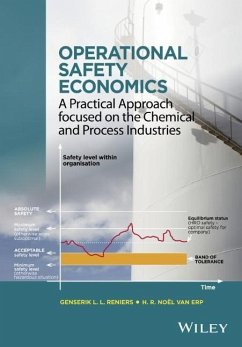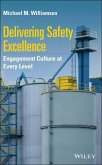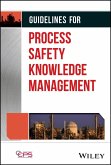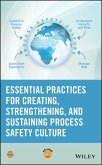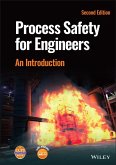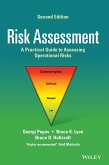Genserik L. L. Reniers, H. R. Noel Van Erp
Operational Safety Economics
A Practical Approach Focused on the Chemical and Process Industries
Genserik L. L. Reniers, H. R. Noel Van Erp
Operational Safety Economics
A Practical Approach Focused on the Chemical and Process Industries
- Gebundenes Buch
- Merkliste
- Auf die Merkliste
- Bewerten Bewerten
- Teilen
- Produkt teilen
- Produkterinnerung
- Produkterinnerung
Describes how to make economic decisions regading safety in the chemical and process industries _ Covers both technical risk assessment and economic aspects of safety decision-making _ Suitable for both academic researchers and practitioners in industry _ Addresses cost-benefit analysis for safety investments
Andere Kunden interessierten sich auch für
![Business Chemistry Business Chemistry]() Business Chemistry107,99 €
Business Chemistry107,99 €![Delivering Safety Excellence Delivering Safety Excellence]() Michael M. WilliamsenDelivering Safety Excellence99,99 €
Michael M. WilliamsenDelivering Safety Excellence99,99 €![Guidelines for Process Safety Knowledge Management Guidelines for Process Safety Knowledge Management]() Center for Chemical Process Safety (CCPS)Guidelines for Process Safety Knowledge Management145,99 €
Center for Chemical Process Safety (CCPS)Guidelines for Process Safety Knowledge Management145,99 €![Essential Practices for Creating, Strengthening, and Sustaining Process Safety Culture Essential Practices for Creating, Strengthening, and Sustaining Process Safety Culture]() Center for Chemical Process Safety (CCPS)Essential Practices for Creating, Strengthening, and Sustaining Process Safety Culture127,99 €
Center for Chemical Process Safety (CCPS)Essential Practices for Creating, Strengthening, and Sustaining Process Safety Culture127,99 €![Leadership by Engineers and Scientists Leadership by Engineers and Scientists]() Dennis W. HessLeadership by Engineers and Scientists81,99 €
Dennis W. HessLeadership by Engineers and Scientists81,99 €![Process Safety for Engineers Process Safety for Engineers]() Center for Chemical Process Safety (CCPS)Process Safety for Engineers167,99 €
Center for Chemical Process Safety (CCPS)Process Safety for Engineers167,99 €![Risk Assessment Risk Assessment]() Georgi PopovRisk Assessment146,99 €
Georgi PopovRisk Assessment146,99 €-
-
-
Describes how to make economic decisions regading safety in the chemical and process industries
_ Covers both technical risk assessment and economic aspects of safety decision-making
_ Suitable for both academic researchers and practitioners in industry
_ Addresses cost-benefit analysis for safety investments
Hinweis: Dieser Artikel kann nur an eine deutsche Lieferadresse ausgeliefert werden.
_ Covers both technical risk assessment and economic aspects of safety decision-making
_ Suitable for both academic researchers and practitioners in industry
_ Addresses cost-benefit analysis for safety investments
Hinweis: Dieser Artikel kann nur an eine deutsche Lieferadresse ausgeliefert werden.
Produktdetails
- Produktdetails
- Verlag: Wiley / Wiley & Sons
- Artikelnr. des Verlages: 1W118871120
- 1. Auflage
- Seitenzahl: 336
- Erscheinungstermin: 17. Oktober 2016
- Englisch
- Abmessung: 244mm x 173mm x 20mm
- Gewicht: 662g
- ISBN-13: 9781118871126
- ISBN-10: 111887112X
- Artikelnr.: 45079753
- Herstellerkennzeichnung
- Libri GmbH
- Europaallee 1
- 36244 Bad Hersfeld
- gpsr@libri.de
- Verlag: Wiley / Wiley & Sons
- Artikelnr. des Verlages: 1W118871120
- 1. Auflage
- Seitenzahl: 336
- Erscheinungstermin: 17. Oktober 2016
- Englisch
- Abmessung: 244mm x 173mm x 20mm
- Gewicht: 662g
- ISBN-13: 9781118871126
- ISBN-10: 111887112X
- Artikelnr.: 45079753
- Herstellerkennzeichnung
- Libri GmbH
- Europaallee 1
- 36244 Bad Hersfeld
- gpsr@libri.de
Genserik Reniers is Professor at the TU Delft (Safety Science Group, Faculty of Technology, Policy and Management, The Netherlands), Professor at the HUB campus of the KULeuven (CEDON, Faculty of Economics and Management, Belgium) and at the University of Antwerp (ARGoSS, Faculty of Applied Economic Sciences, Belgium). He received his PhD in Applied Economic Sciences from the University of Antwerp, after completing a Master's degree in Chemical Engineering at the Vrije Universiteit Brussels. His main research interests concern the collaboration and interaction between safety and security topics and socio-economic optimization within the chemical industry. Genserik has authored, co-authored, edited or co-edited more than 20 books in the field of safety and/or security in the process industries, and he is Receiving editor for the Journal of Loss Prevention in the Process Industries (JLPPI), and Associate Editor of Safety Science, two very well-known academic journals in the research field. He has taught safety and security economics (as part of larger courses) since 2006 both at the University of Antwerp and at the HUB-campus of the KULeuven.
Preface xi
Disclaimer xiv
Acknowledgements xv
List of Acronyms xvii
1 Introduction 1
1.1 The "Why" of Operational Safety 1
1.2 Back to the Future: the Economics of Operational Safety 3
1.3 Difficulties in Operational Safety Economics 4
1.4 The Field of Operational Safety within the Profitability of an Organization 5
1.5 Conclusions 6
References 7
2 Operational Risk, Operational Safety, and Economics 8
2.1 Defining the Concept of Operational Risk 8
2.2 Dealing with Operational Risks 10
2.3 Types of Operational Risk 11
2.4 The Importance of Operational Safety Economics for a Company 15
2.5 Balancing between Productivity and Safety 18
2.6 The Safety Equilibrium Situation or "HRO Safety" 19
2.6.1 HRO Principle 1: Targeted at Disturbances 20
2.6.2 HRO Principle 2: Reluctant for Simplification 21
2.6.3 HRO Principle 3: Sensitive toward Implementation 21
2.6.4 HRO Principle 4: Devoted to Resiliency 21
2.6.5 HRO Principle 5: Respectful for Expertise 22
2.7 The Egg Aggregated Model (TEAM) of Safety Culture 22
2.8 Safety Futures 24
2.9 The Controversy of Economic Analyses 25
2.10 Scientific Requirements for Adequate Economic Assessment Techniques 26
2.11 Four Categories of Data 27
2.12 Improving Decision-making Processes for Investing in Safety 28
2.13 Conclusions 29
References 30
3 Economic Foundations 31
3.1 Macroeconomics and Microeconomics 31
3.2 Safety Demand and Long-term Average Cost of Production 32
3.2.1 Safety Demand 32
3.2.2 Long-term Average Cost of Production and Safety 33
3.3 Safety Value Function 35
3.4 Expected Value Theory, Value at Risk, and Safety Attitude 37
3.4.1 Expected Value Theory 37
3.4.2 Value at Risk 38
3.4.3 Safety Attitude 39
3.5 Safety Utilities 40
3.5.1 Safety Utility Functions 40
3.5.2 Expected Utility and Certainty Equivalent 41
3.6 Measuring Safety Utility Functions 42
3.7 Preferences of Safety Management - Safety Indifference Curves 43
3.8 Measuring Safety Indifference Curves 45
3.8.1 Questionnaire-based Type I Safety Indifference Curves 45
3.8.2 Problems with Determining an Indifference Curve 48
3.8.3 Time Trade-off-based Safety Utilities for Type II Safety Indifference Curves 48
3.9 Budget Constraint and n-Dimensional Maximization Problem Formulation 50
3.10 Determining Optimal Safety Management Preferences within the Budget Constraint for a Two-dimensional Problem 52
3.11 Conclusions 54
References 54
4 Operational Safety Decision-making and Economics 55
4.1 Economic Theories and Safety Decisions 55
4.1.1 Introduction 55
4.1.2 Expected Utility Theory 56
4.1.3 Prospect Theory 56
4.1.4 Bayesian Decision Theory 60
4.1.5 Risk and Uncertainty 60
4.1.6 Making a Choice Out of a Set of Options 62
4.1.7 Impact of Affect and Emotion in the Process of Making a Choice between Alternatives 64
4.1.8 Influence of Regret and Disappointment on Decision-making 64
4.1.9 Impact of Intuition on Decision-making 65
4.1.10 Other Influences while Making Decisions 66
4.2 Making Decisions to Deal with Operational Safety 66
4.2.1 Introduction 66
4.2.2 Risk Treatment Option 1: Risk Reduction 67
4.2.3 Risk Treatment Option 2: Risk Acceptance 69
&
Disclaimer xiv
Acknowledgements xv
List of Acronyms xvii
1 Introduction 1
1.1 The "Why" of Operational Safety 1
1.2 Back to the Future: the Economics of Operational Safety 3
1.3 Difficulties in Operational Safety Economics 4
1.4 The Field of Operational Safety within the Profitability of an Organization 5
1.5 Conclusions 6
References 7
2 Operational Risk, Operational Safety, and Economics 8
2.1 Defining the Concept of Operational Risk 8
2.2 Dealing with Operational Risks 10
2.3 Types of Operational Risk 11
2.4 The Importance of Operational Safety Economics for a Company 15
2.5 Balancing between Productivity and Safety 18
2.6 The Safety Equilibrium Situation or "HRO Safety" 19
2.6.1 HRO Principle 1: Targeted at Disturbances 20
2.6.2 HRO Principle 2: Reluctant for Simplification 21
2.6.3 HRO Principle 3: Sensitive toward Implementation 21
2.6.4 HRO Principle 4: Devoted to Resiliency 21
2.6.5 HRO Principle 5: Respectful for Expertise 22
2.7 The Egg Aggregated Model (TEAM) of Safety Culture 22
2.8 Safety Futures 24
2.9 The Controversy of Economic Analyses 25
2.10 Scientific Requirements for Adequate Economic Assessment Techniques 26
2.11 Four Categories of Data 27
2.12 Improving Decision-making Processes for Investing in Safety 28
2.13 Conclusions 29
References 30
3 Economic Foundations 31
3.1 Macroeconomics and Microeconomics 31
3.2 Safety Demand and Long-term Average Cost of Production 32
3.2.1 Safety Demand 32
3.2.2 Long-term Average Cost of Production and Safety 33
3.3 Safety Value Function 35
3.4 Expected Value Theory, Value at Risk, and Safety Attitude 37
3.4.1 Expected Value Theory 37
3.4.2 Value at Risk 38
3.4.3 Safety Attitude 39
3.5 Safety Utilities 40
3.5.1 Safety Utility Functions 40
3.5.2 Expected Utility and Certainty Equivalent 41
3.6 Measuring Safety Utility Functions 42
3.7 Preferences of Safety Management - Safety Indifference Curves 43
3.8 Measuring Safety Indifference Curves 45
3.8.1 Questionnaire-based Type I Safety Indifference Curves 45
3.8.2 Problems with Determining an Indifference Curve 48
3.8.3 Time Trade-off-based Safety Utilities for Type II Safety Indifference Curves 48
3.9 Budget Constraint and n-Dimensional Maximization Problem Formulation 50
3.10 Determining Optimal Safety Management Preferences within the Budget Constraint for a Two-dimensional Problem 52
3.11 Conclusions 54
References 54
4 Operational Safety Decision-making and Economics 55
4.1 Economic Theories and Safety Decisions 55
4.1.1 Introduction 55
4.1.2 Expected Utility Theory 56
4.1.3 Prospect Theory 56
4.1.4 Bayesian Decision Theory 60
4.1.5 Risk and Uncertainty 60
4.1.6 Making a Choice Out of a Set of Options 62
4.1.7 Impact of Affect and Emotion in the Process of Making a Choice between Alternatives 64
4.1.8 Influence of Regret and Disappointment on Decision-making 64
4.1.9 Impact of Intuition on Decision-making 65
4.1.10 Other Influences while Making Decisions 66
4.2 Making Decisions to Deal with Operational Safety 66
4.2.1 Introduction 66
4.2.2 Risk Treatment Option 1: Risk Reduction 67
4.2.3 Risk Treatment Option 2: Risk Acceptance 69
&
Preface xi
Disclaimer xiv
Acknowledgements xv
List of Acronyms xvii
1 Introduction 1
1.1 The "Why" of Operational Safety 1
1.2 Back to the Future: the Economics of Operational Safety 3
1.3 Difficulties in Operational Safety Economics 4
1.4 The Field of Operational Safety within the Profitability of an Organization 5
1.5 Conclusions 6
References 7
2 Operational Risk, Operational Safety, and Economics 8
2.1 Defining the Concept of Operational Risk 8
2.2 Dealing with Operational Risks 10
2.3 Types of Operational Risk 11
2.4 The Importance of Operational Safety Economics for a Company 15
2.5 Balancing between Productivity and Safety 18
2.6 The Safety Equilibrium Situation or "HRO Safety" 19
2.6.1 HRO Principle 1: Targeted at Disturbances 20
2.6.2 HRO Principle 2: Reluctant for Simplification 21
2.6.3 HRO Principle 3: Sensitive toward Implementation 21
2.6.4 HRO Principle 4: Devoted to Resiliency 21
2.6.5 HRO Principle 5: Respectful for Expertise 22
2.7 The Egg Aggregated Model (TEAM) of Safety Culture 22
2.8 Safety Futures 24
2.9 The Controversy of Economic Analyses 25
2.10 Scientific Requirements for Adequate Economic Assessment Techniques 26
2.11 Four Categories of Data 27
2.12 Improving Decision-making Processes for Investing in Safety 28
2.13 Conclusions 29
References 30
3 Economic Foundations 31
3.1 Macroeconomics and Microeconomics 31
3.2 Safety Demand and Long-term Average Cost of Production 32
3.2.1 Safety Demand 32
3.2.2 Long-term Average Cost of Production and Safety 33
3.3 Safety Value Function 35
3.4 Expected Value Theory, Value at Risk, and Safety Attitude 37
3.4.1 Expected Value Theory 37
3.4.2 Value at Risk 38
3.4.3 Safety Attitude 39
3.5 Safety Utilities 40
3.5.1 Safety Utility Functions 40
3.5.2 Expected Utility and Certainty Equivalent 41
3.6 Measuring Safety Utility Functions 42
3.7 Preferences of Safety Management - Safety Indifference Curves 43
3.8 Measuring Safety Indifference Curves 45
3.8.1 Questionnaire-based Type I Safety Indifference Curves 45
3.8.2 Problems with Determining an Indifference Curve 48
3.8.3 Time Trade-off-based Safety Utilities for Type II Safety Indifference Curves 48
3.9 Budget Constraint and n-Dimensional Maximization Problem Formulation 50
3.10 Determining Optimal Safety Management Preferences within the Budget Constraint for a Two-dimensional Problem 52
3.11 Conclusions 54
References 54
4 Operational Safety Decision-making and Economics 55
4.1 Economic Theories and Safety Decisions 55
4.1.1 Introduction 55
4.1.2 Expected Utility Theory 56
4.1.3 Prospect Theory 56
4.1.4 Bayesian Decision Theory 60
4.1.5 Risk and Uncertainty 60
4.1.6 Making a Choice Out of a Set of Options 62
4.1.7 Impact of Affect and Emotion in the Process of Making a Choice between Alternatives 64
4.1.8 Influence of Regret and Disappointment on Decision-making 64
4.1.9 Impact of Intuition on Decision-making 65
4.1.10 Other Influences while Making Decisions 66
4.2 Making Decisions to Deal with Operational Safety 66
4.2.1 Introduction 66
4.2.2 Risk Treatment Option 1: Risk Reduction 67
4.2.3 Risk Treatment Option 2: Risk Acceptance 69
&
Disclaimer xiv
Acknowledgements xv
List of Acronyms xvii
1 Introduction 1
1.1 The "Why" of Operational Safety 1
1.2 Back to the Future: the Economics of Operational Safety 3
1.3 Difficulties in Operational Safety Economics 4
1.4 The Field of Operational Safety within the Profitability of an Organization 5
1.5 Conclusions 6
References 7
2 Operational Risk, Operational Safety, and Economics 8
2.1 Defining the Concept of Operational Risk 8
2.2 Dealing with Operational Risks 10
2.3 Types of Operational Risk 11
2.4 The Importance of Operational Safety Economics for a Company 15
2.5 Balancing between Productivity and Safety 18
2.6 The Safety Equilibrium Situation or "HRO Safety" 19
2.6.1 HRO Principle 1: Targeted at Disturbances 20
2.6.2 HRO Principle 2: Reluctant for Simplification 21
2.6.3 HRO Principle 3: Sensitive toward Implementation 21
2.6.4 HRO Principle 4: Devoted to Resiliency 21
2.6.5 HRO Principle 5: Respectful for Expertise 22
2.7 The Egg Aggregated Model (TEAM) of Safety Culture 22
2.8 Safety Futures 24
2.9 The Controversy of Economic Analyses 25
2.10 Scientific Requirements for Adequate Economic Assessment Techniques 26
2.11 Four Categories of Data 27
2.12 Improving Decision-making Processes for Investing in Safety 28
2.13 Conclusions 29
References 30
3 Economic Foundations 31
3.1 Macroeconomics and Microeconomics 31
3.2 Safety Demand and Long-term Average Cost of Production 32
3.2.1 Safety Demand 32
3.2.2 Long-term Average Cost of Production and Safety 33
3.3 Safety Value Function 35
3.4 Expected Value Theory, Value at Risk, and Safety Attitude 37
3.4.1 Expected Value Theory 37
3.4.2 Value at Risk 38
3.4.3 Safety Attitude 39
3.5 Safety Utilities 40
3.5.1 Safety Utility Functions 40
3.5.2 Expected Utility and Certainty Equivalent 41
3.6 Measuring Safety Utility Functions 42
3.7 Preferences of Safety Management - Safety Indifference Curves 43
3.8 Measuring Safety Indifference Curves 45
3.8.1 Questionnaire-based Type I Safety Indifference Curves 45
3.8.2 Problems with Determining an Indifference Curve 48
3.8.3 Time Trade-off-based Safety Utilities for Type II Safety Indifference Curves 48
3.9 Budget Constraint and n-Dimensional Maximization Problem Formulation 50
3.10 Determining Optimal Safety Management Preferences within the Budget Constraint for a Two-dimensional Problem 52
3.11 Conclusions 54
References 54
4 Operational Safety Decision-making and Economics 55
4.1 Economic Theories and Safety Decisions 55
4.1.1 Introduction 55
4.1.2 Expected Utility Theory 56
4.1.3 Prospect Theory 56
4.1.4 Bayesian Decision Theory 60
4.1.5 Risk and Uncertainty 60
4.1.6 Making a Choice Out of a Set of Options 62
4.1.7 Impact of Affect and Emotion in the Process of Making a Choice between Alternatives 64
4.1.8 Influence of Regret and Disappointment on Decision-making 64
4.1.9 Impact of Intuition on Decision-making 65
4.1.10 Other Influences while Making Decisions 66
4.2 Making Decisions to Deal with Operational Safety 66
4.2.1 Introduction 66
4.2.2 Risk Treatment Option 1: Risk Reduction 67
4.2.3 Risk Treatment Option 2: Risk Acceptance 69
&

